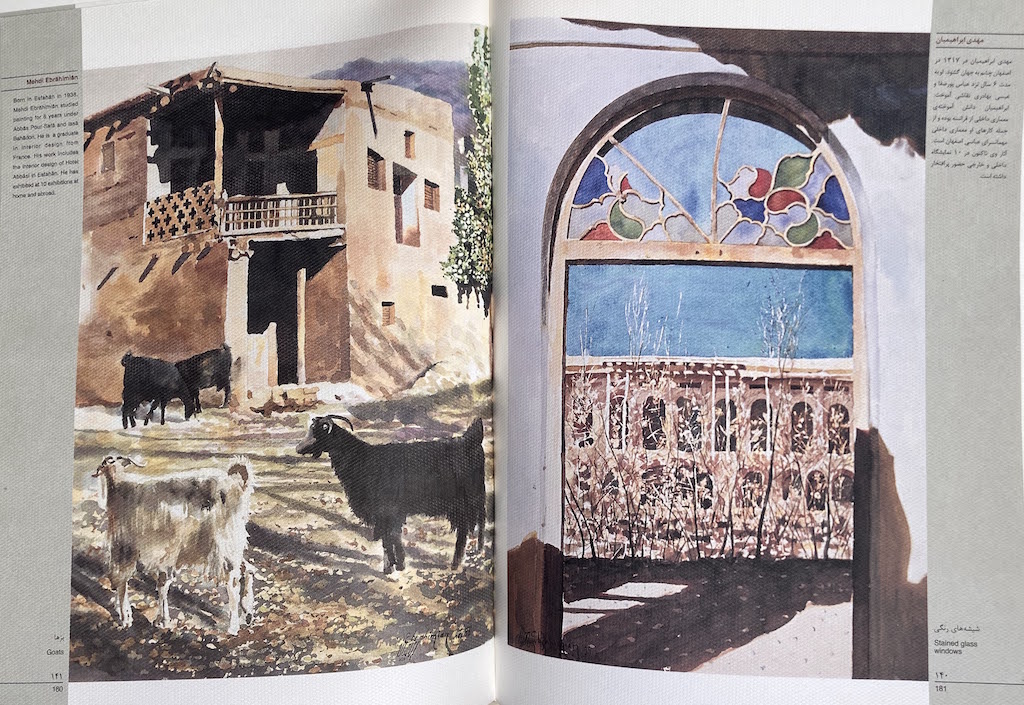Master Of The Persian Arts
For his significant contributions in interior architecture, furniture design, and painting, artist and designer Mehdi Ebrahimian (1938-2023) is world-renowned and recognized as one of the extraordinary masters of Persian Art, coined as the “Iranian da Vinci,” by Arthur Upham Pope, the prominent art historian.
Mr. Ebrahimian’s personal drive in restoration and revival of old Persian arts is reflected through his work and lifestyle.
Mehdi Ebrahimian’s legacy of work is a celebration of Persian Arts spanning the vast scope of its remarkable history.
Whilst Mehdi Ebrahimian has been accredited in publications, this website provides a flavour of the breadth and depth of his work and efforts, as the foremost exponent of the Persian Arts, to tireless spotlight the “roots of Persian art.”
For over 60 years, this Iranian da Vinci has breathed, created, collected and even literally preserved the paradisiac Persian arts.
The seeds for the love of art were planted early on: Looming of age in Isfahan, Iran, Mehdi Ebrahimian attended the Isfahan School of Fine Arts, studying under the late art masters, Poursafa and Eisa Bahadori. He proceeded with his academic career at the École Nationale Supérieure des Arts Décoratifs in Paris where he focused his studies on interior architecture.
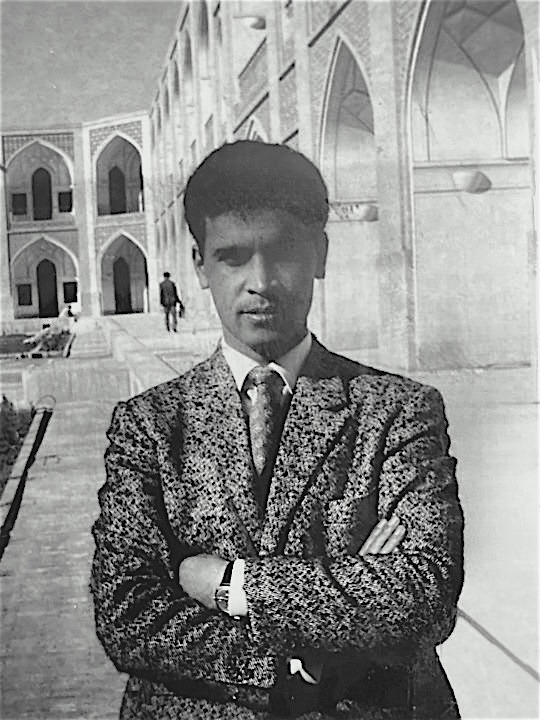
Designing the Enchanting World inside the Abbasi Hotel
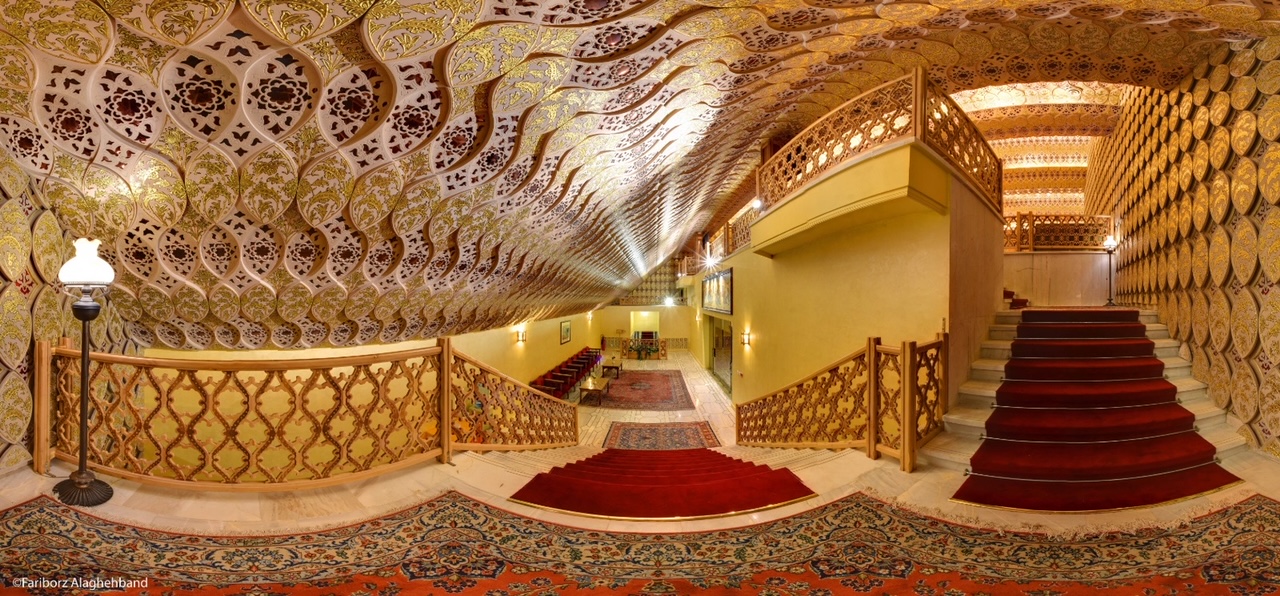
Mr. Ebrahimian’s passion for interior spaces and the revival of historical Persian design is most notably visible in the renovation of the historic Abbasi Hotel.
As the lead architect, he designed and trained local workers to construct the grand spaces we see today that showcase the rich splendors of the Safavids and Qajar dynasties. These designs are what transformed this 300 year old site into what is widely known as one of the most beautiful hotels in the world. Even the furniture is of Ebrahimian design and hand crafted by renowned Iranian Master Javad Chaichi.
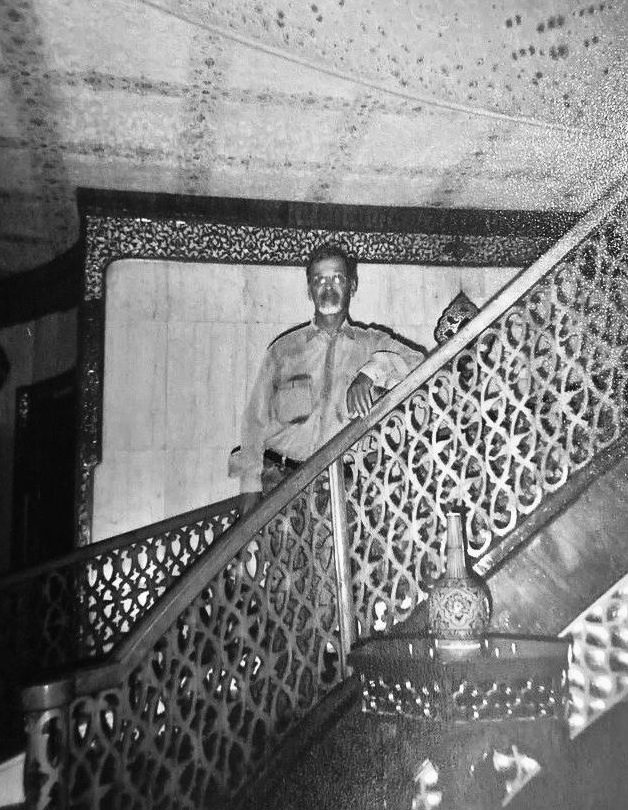
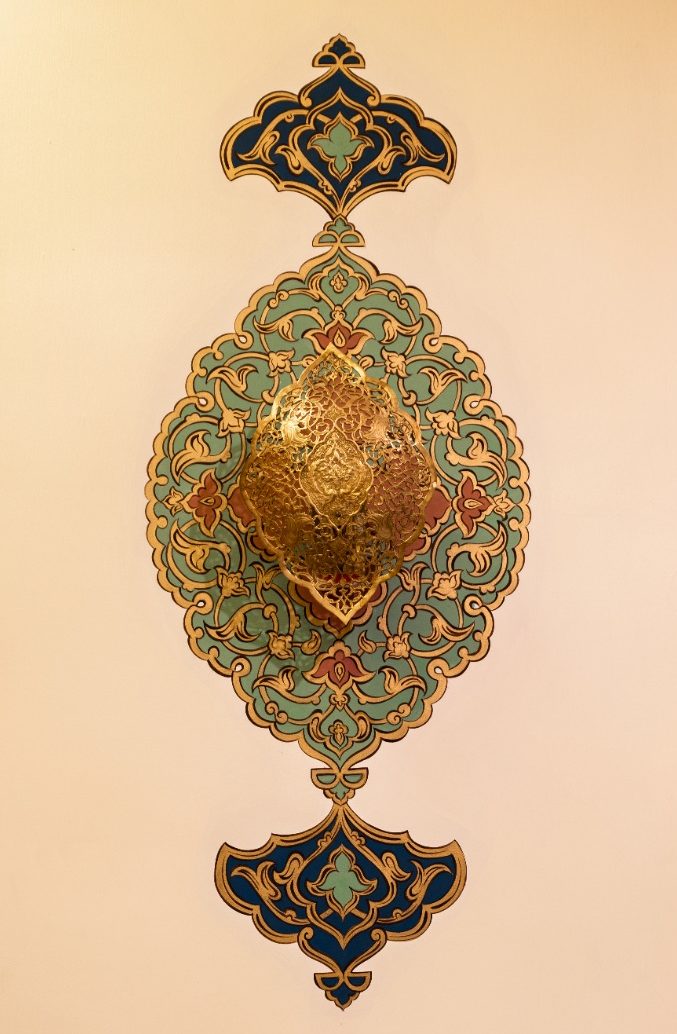
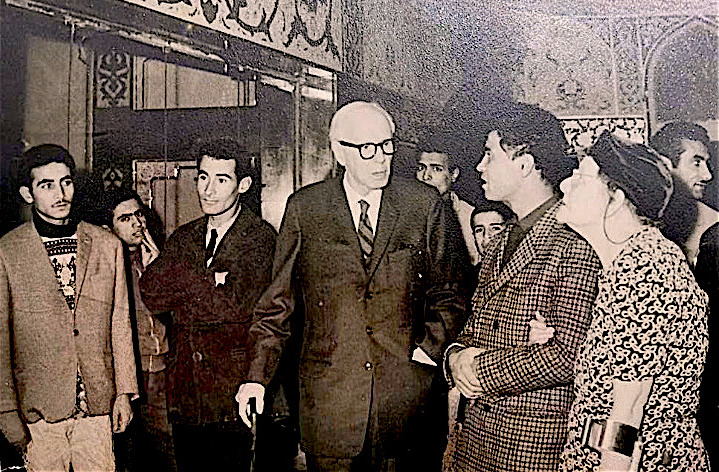
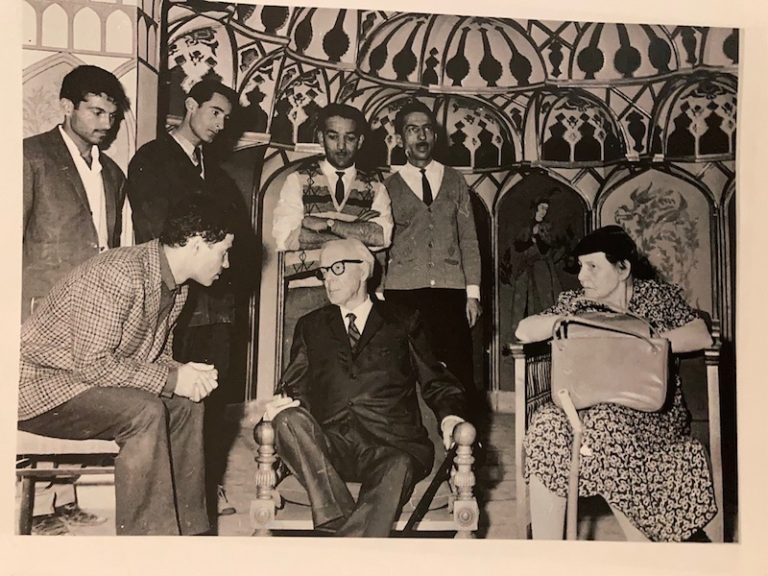
Mehdi Ebrahmian with the renowned art historian Arthur Upham Pope and Phyllis Murray and the trained and talented craftmen of the Abbasi Hotel.
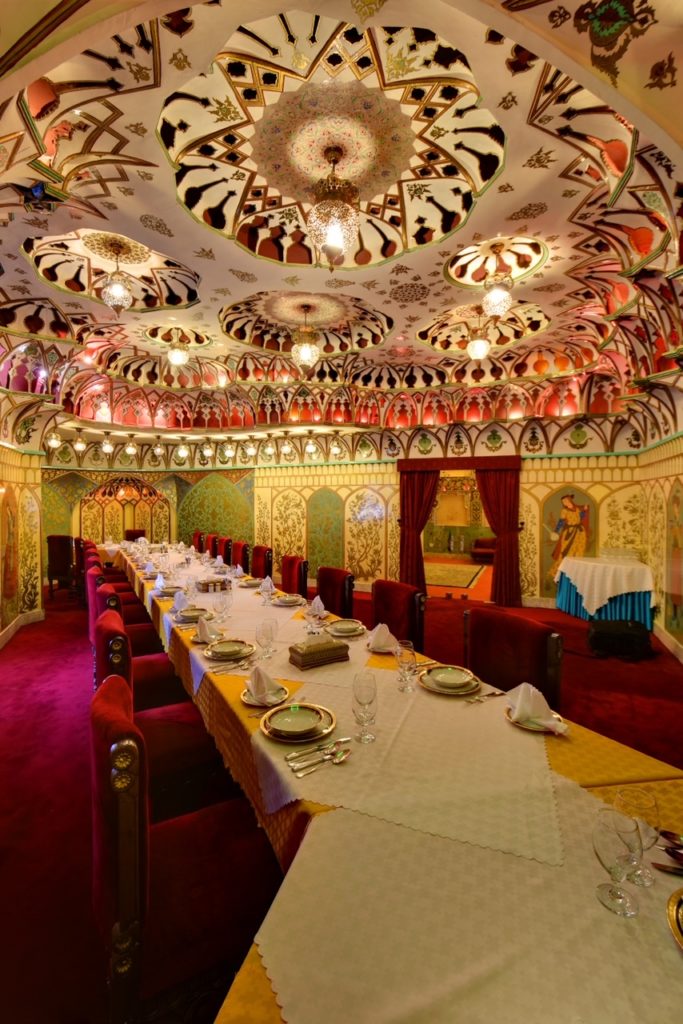
The Abbasi restaurant with the Ali Qapu-style ceiling.
Designing Waldorf Astoria’s Iranian restaurant
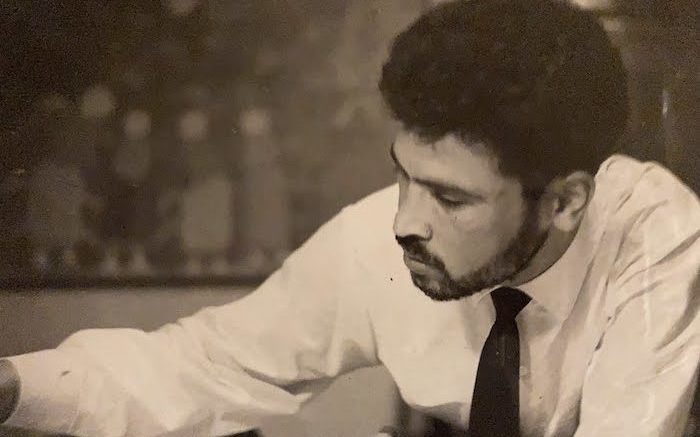
Mehdi Ebrahimian adapted a similar approach to designing the Waldorf Astoria Persian restaurants, considered to be one of the most luxurious restaurants in New York in the late 1970s. He refined details such as dinnerware with Persian motifs and domes that matched the dome of the sacred mosque at Isfahan. Eight feet high walls were covered with 1,000 square feet of mosaic mirrors.
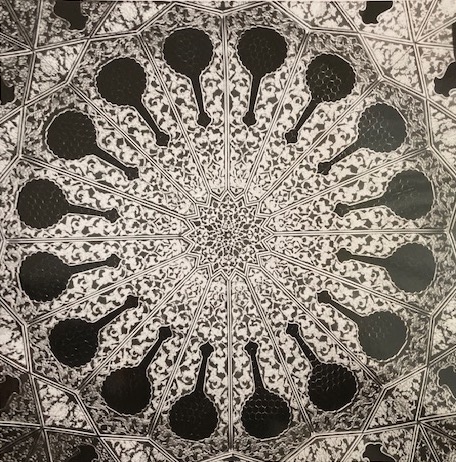

Branching out with Persian designs
In designing for international art exhibitions across the globe (e.g., Afghanistan, Canada, Japan and Kuwait), he once again drew inspiration from artwork of old Persian artwork. For instance, the design for the Montreal exhibition at the Iranian Pavillion was inspired by roses on the tile of the Sayyid Mosque that wrap around each other and rise.
Contemporary designs reflect include Persian style mirror work and stuccos at the Iranian residences of the United Nations ambassadors in Paris, New York, Brussels and Moscow.
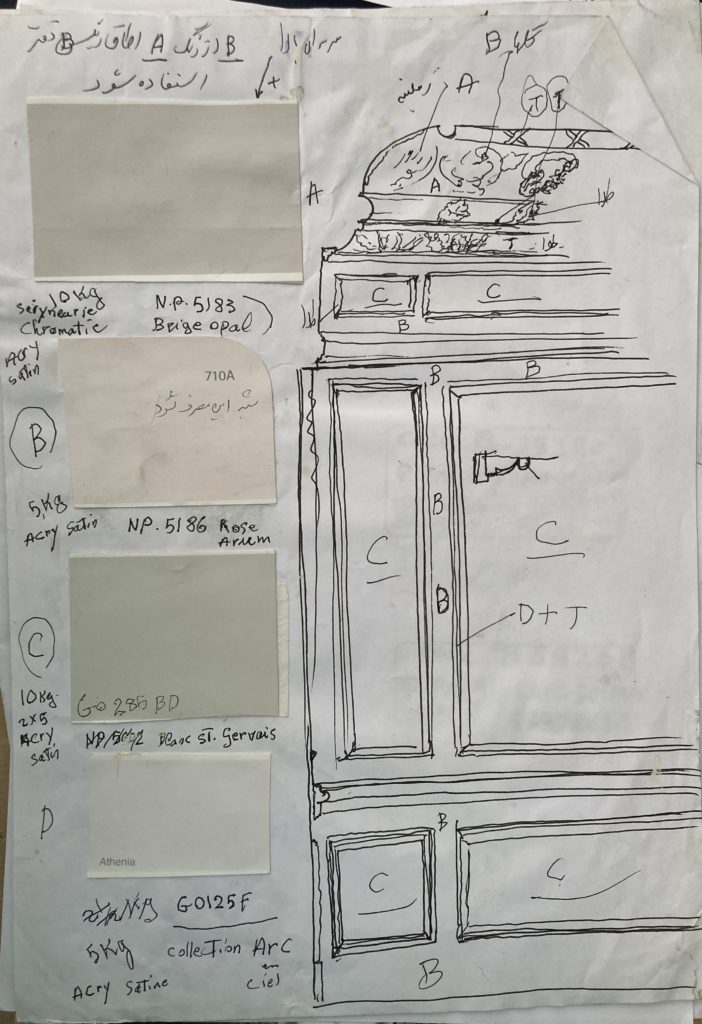
Master Craftsman
Mr. Ebrahimian is also a skilled painter and craftsman. As one of the pioneers of Persian handicraft, he and his wife, Violette Dehghani, were both frequently consulted and their works featured in numerous publications. One can find the artist cited in publications such as ones of the great historian, Arthur Upham Pope, in A Survey of Persian Art: from Prehistoric Times to the Present and Jay and Sumi Gluck’s A Survey of Persian Handicraft.
He met Ms. Dehghani, an established artist and designer, whilst she was working at the newly-established Handicrafts Center of the Ministry of Economy. Together, with Master Mohammed Naraghi, they adapted techniques and designs that highlighted old Persian craft in household items, which were sold in Zinat Sara, their handicraft gallery, in Tehran. Even the designed silk fabrics celebrated Persian art and culture, with figures that narrated scenes from the Persian literature.
Mr. Ebrahimian continued to reach even deeper into his cultural history drawing inspiration for his paintings, sculptures, furniture, and decorative pieces utilizing design elements from ancient Persepolis and other ancient Persian artifacts.
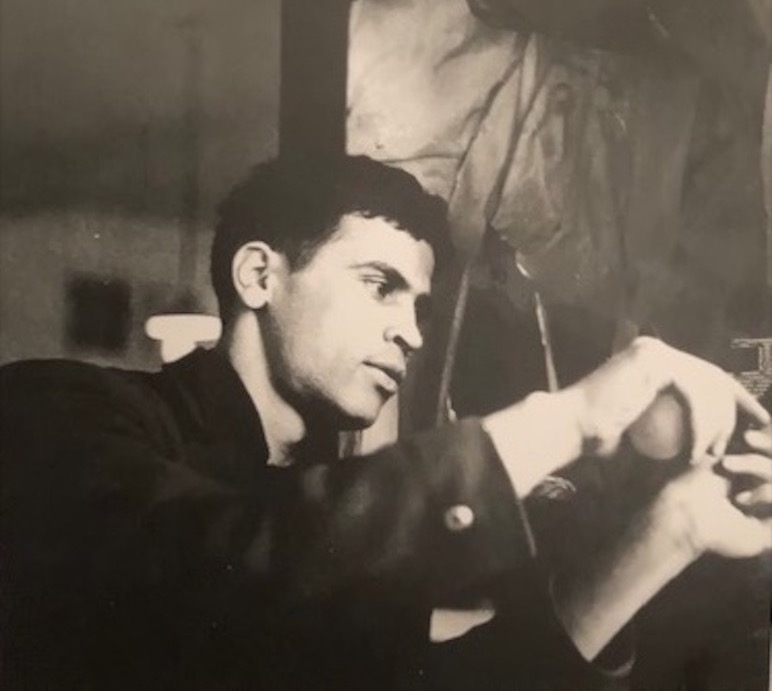
Mehdi Ebrahimian’s works create bridges from our modern day understanding of Persian design to the historical periods of Persian arts, encompassing the fine detail of hand crafted objects all the way to expansive grand interiors.
His work and legacy is referenced and featured in a variety of news articles and television broadcasts.
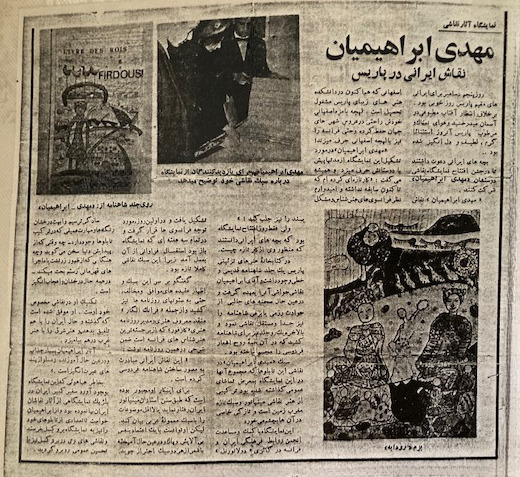
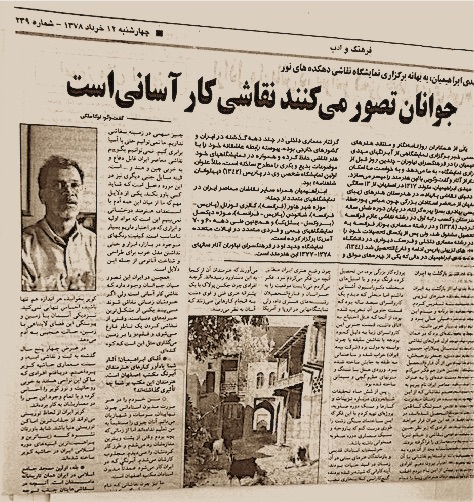


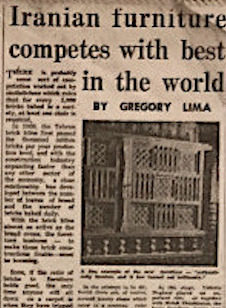
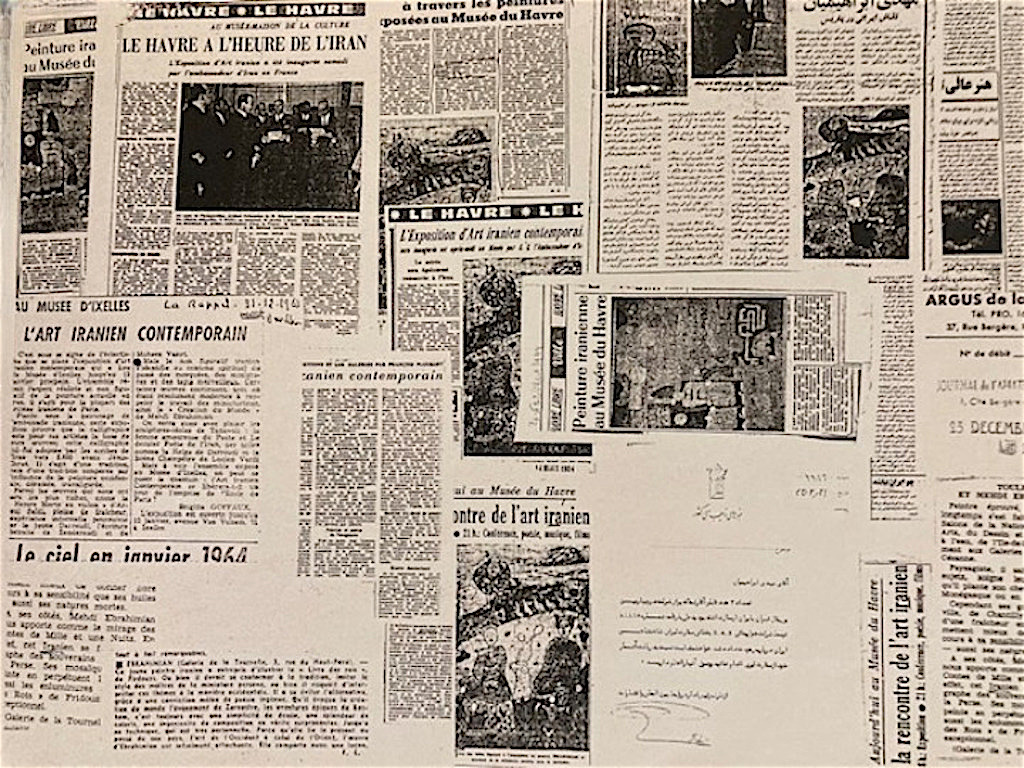
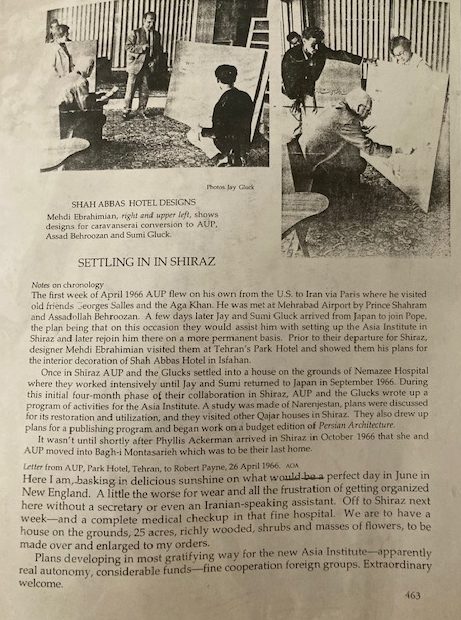
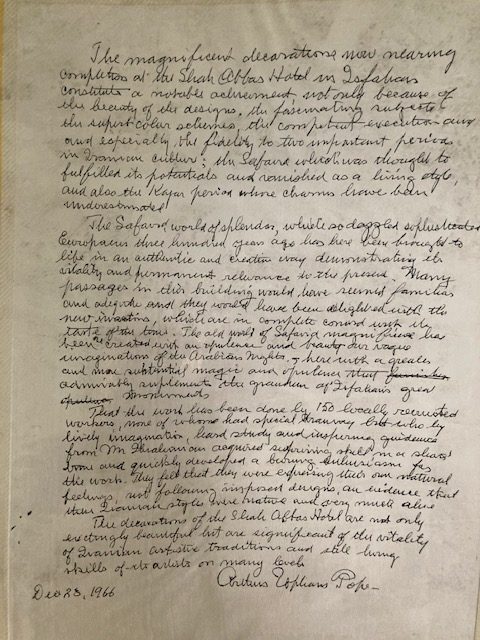
“The magnificent decorations now nearing completion at the Shah Abbas Hotel in Isfahan constitutes a notable achievement, not only because of the beauty of the designs, the fascinating subjects the superb color schemes, the competent execution and especially the fidelity of the important period in Iranian culture; the Safavid which was to fulfilled its potentials and vanished as a living style, and also the Qajar period whose charms have been understood.
The Safavid, world of splendors, which so dazzled sophisticated Europeans three hundred years ago has here been brought to life in an authentic and creative way demonstrating the vitality and prominent relevance to the present. Any passages in this building would have seemed familiar and adequate and they would have been delighted with its new inventions, which are in complete accord with the taste of the times. The old world of Safavid magnificence has been created with an influence and beauty [in] our vague imaginations of the Arabian Nights. Here with a great and new substantial magic and opulence that admirably supplements the grandeur of Isfahan’s great monuments.
That the work has been done by 150 locally recruited workers, none of whom had special survey but who by lively imagination, heard study and inspiring guidance from Mr. Ebrahimian acquired supervising skill and shared the work. They felt that they were expressing items on natural feelings, not following imposed designs, an evidence that the Iranian Styles were mature and very much alive.
The decorations of the Shah Abbas Hotel are not only excitingly beautiful, bare and significant of the vitality of Iranian Artistic traditions and still having skills of its artist of many levels.”
-Arthur Upham Pope, 23 December 1966
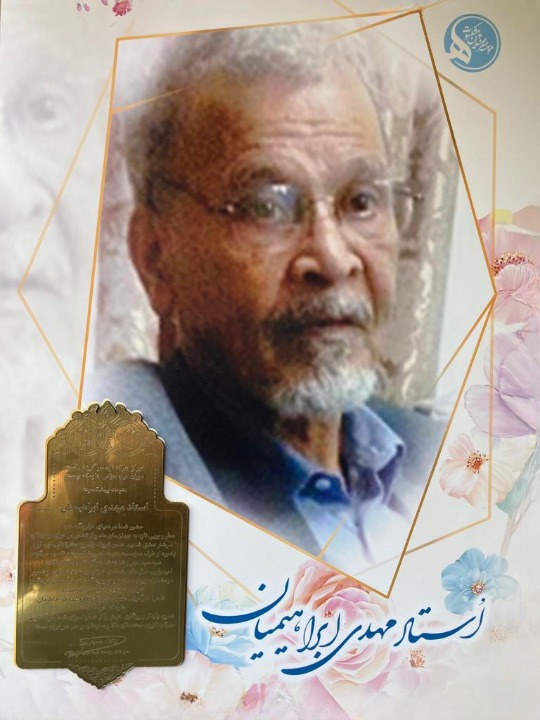
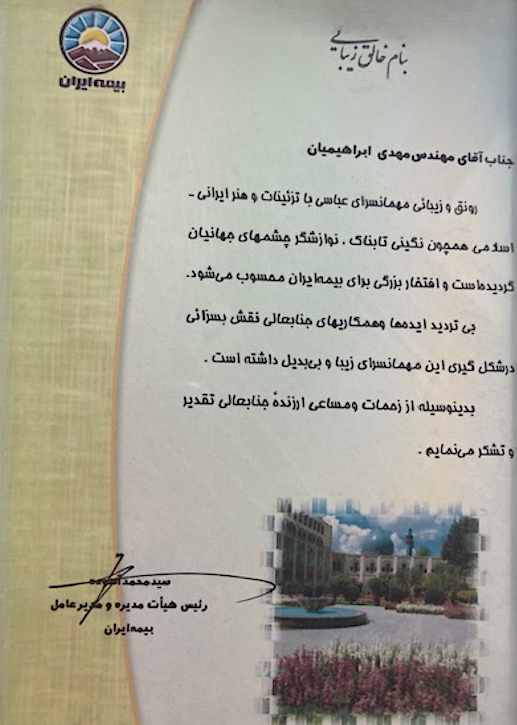
Selected projects
Design and supervision of 10 Tehran subway stations, Iran
Interior design of Teen Restaurant in Tehran, Iran
Interior design and reconstruction of corridors, rooms and gyms of Abbasi Hotel in Isfahan, Iran
Interior design of Kerman International Grand Hotel in Kerman, Iran
Architecture and interior design of Iran Insurance Building (Bazaar Branch)
Design, construction and execution of more than a dozen residential and commercial buildings in New York / New Jersey / Washington DC and California, USA
Design and supervision of more than 50 residential areas in France and Germany
High supervision in the execution of the new shrine of Hazrat Reza in Mashhad, Iran
Renovation of the garden of the Iranian Embassy in Paris, France
Design and supervision of more than 50 residential areas in Tehran /Shiraz /Ahvaz /Tabriz and Isfahan, Iran
Architecture & Interior Design of the Five Star Restaurant of Oriental Food of Waldorf Astoria Hotel in New York, USA
Interior architecture and conversion of Lavizan Palace building into a guest house in Tehran, Iran
Architecture and Interior Architecture of the Tehran Philosophy Association in Tehran, Iran
Architecture and design of Iranian pavilions in foreign exhibitions in Russia/ Afghanistan/ Kuwait
Architecture and design of industrial stalls in Asian exhibitions in Tehran, Iran
Design and supervision in the reconstruction of the garden and yard of Narenjestan in Shiraz, Iran
Interior design of Tea Shop Japanese restaurant in Tehran
Architecture and interior design and conversion of an old building into the Kings Hotel in Tehran, Iran
Interior design and architecture of Abbasi Guest House lecture hall in Isfahan, Iran
Interior design and architecture and decoration of the ancient part of the Abbasi Hotel in Isfahan, Iran
The interior architecture of Paramount and Cenemonde cinemas in Tehran, Iran
Design and interior design consulting of Asaka international Exhibition in Japan
Interior Design and Architecture Consulting of Montreal International Exhibition in Canada
Design and interior design consulting of Saderat Bank building in Dubai, United Arab Emirates
Design and implementation of halls and reception areas for heads of state and guests of the Iranian government
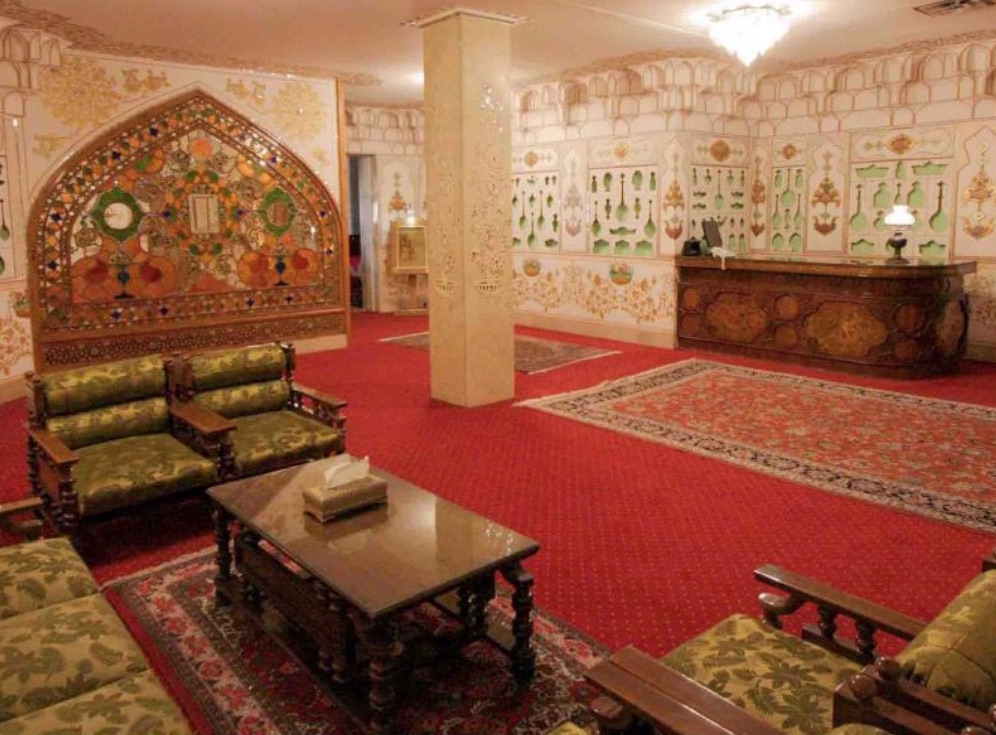
Selected citations
Pope, Arthur Upham & Phyllis Ackerman. A Survey of Persian Art: from Prehistoric Times to the Present, Published by Oxford University Press, 1967
Gluck, Jay & Sumi, A Survey of Persian Handicraft, Published by Personally Oriented Ltd, Japan, 1977
Photographs of Fakhraddin Fakhraddini (portrait of masters of arts and literature), no. 22, Tehran, 2004
Encyclopedia of Contemporary Iranian Prominent Figures, Vol. 2, pp.58-60, The Bureau for the Islamic Revolution Literature Tehran, 2005
Abbasi Hotel, Museum within a Museum, Iran Insurance Company, 1997
Abbasi Hotel website (http://abbasihotel.ir/tour/all/)
Iranica Online (https://www.iranicaonline.org/articles/crafts-)
Interview with Mehdi Ebrahimian and Violet Dehghani about the Abbasi Hotel (https://memari.online/21800/ )
Recipient of award in the field of architecture (https//memari.online)
The Glory of Persian Watercolor, Negarestan Collection 30, Negar Books (below is a photo of relevant pages from the book)
